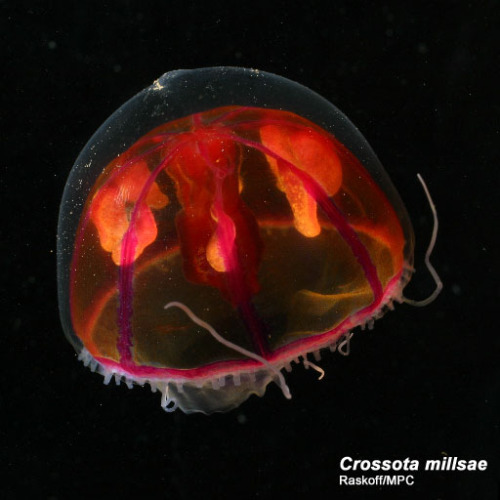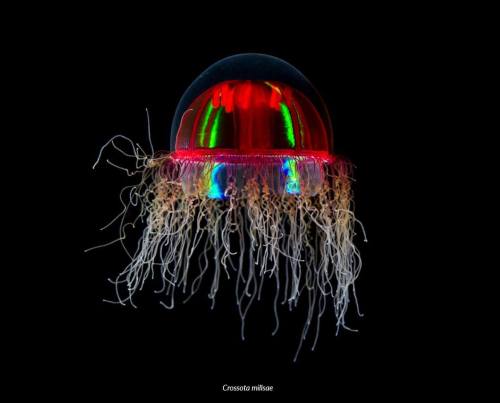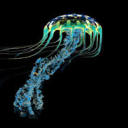Physonect Siphonophore


Physonect Siphonophore
Nanomia cara
The Physonect siphonophore has tiny, bubble shaped sacs that are filled with gas. The sacs are called pneumatophores and help this creature move through the deep ocean. It also has venomous tentacles that stun prey and over eighty stomachs. There are numerous amounts of these strange creatures along the east coast, and they have cause some fisheries to collapse. Furthermore, they can be found at depth between 400m to 1000m.
Photo credit: http://www.seawater.no/fauna/cnidaria/cara.html
https://www.mindenpictures.com/stock-photo-siphonophore-hydrozoan-cnidarian-nanomia-cara-atlantic-nectophores-naturephotography-image90194961.html
More Posts from Bioluminescentoceangoddess and Others

Glass Octopus
Vitreledonella richardi
The Glass Octopus spend its entire life in the midwater section of the ocean and found at depths between 200m to 2000m. Even though it has no protection from predators, it achieves perfect transparency. The only part of the Glass Octopus that is visible is its digestive gland. However, the digestive gland is placed vertically to minimize detection. In addition, I find this octopus to be super cute!
Photo credit: https://www.mynumer.com/forums/topic/499/invisible-animals/view/post_id/859


Helmet Jelly
Periphylla periphylla
The Helmet Jelly can be found at all depths of the ocean. This vibrant and strange jellyfish tends to proliferate in Norwegian fjords. They are one of the dominant predators in these isolated ecosystems.
Photos
http://www.seawater.no/fauna/cnidaria/periphylla.html
https://www.bigfishexpeditions.com/2019/01/24/norway-deepwater-shark-diving-2018/helmet-jelly/





Wake up babe new fish dropped


Pink Helmet
Aglantha digitale
The Pink Helmet is a mini hydromedusa that comes in a variety of vibrant colors. The tiny jelly is only 4 cm in size and is found towards the surface of the ocean. The purple and blue hues we see in its bell are caused by a phenomenon known as iridescence, when light strikes the jelly’s thin tissue at different angles (similar to what we see in a soap bubbles). It also has orange pigmentation near its mouth; this pigmentation helps attract prey and mask luminescence. Furthermore, females tend to be more colorful than males.
Photo credit: https://biolum.eemb.ucsb.edu/organism/pictures/aglantha.html
https://www.pinterest.com/pin/186899453255850798/


Psychedelic Medusa
Crossota millsae
The Psychedelic Medusa is a deep-sea hydrozoan that is abundant in the North Pacific. The mini-jelly is found at depths between 1000m to 3800m, and are often observed drifting near the ocean floor. It also has an eccentric reproduction behavior uncommon in cnidarians. The females display viviparity, and carry the babies in her bell until they are ready to hatch.
Photo credit: http://www.arcodiv.org/watercolumn/cnidarian/Crossota_millsae.html
https://twitter.com/spothvegr/status/1030177493075079169


Googly-eyed glass squid
Teuthowenia pellucida
The Googly eyed squid is a rare oddity that is found in the southern hemisphere. It has a large, spherical head that is filled with water and teeny, tiny tentacles that help propel it through the water. If it comes across a predator, it deflates its head and draws its tentacles into its cavity. On the other hand, it may also fill the cavity with water to increase its size, and intimidate the predator. If all fails, it will ink and try to escape through the darkness. Furthermore, baby squids can be found at the surface (0-600m); then slowly migrate downwards as they mature into adults (1600-2500m).
Photo credit: http://animaladay.blogspot.com/2011/07/googly-eyed-glass-squid.html
https://faunafabula.tumblr.com/post/5999675353/googly-eyed-glass-squid-teuthowenia-pellucida


Pigbutt worm
Chaetopterus pugaporcinus
The Pigbutt worm or the flying buttocks of the sea is spotted floating between 965 m to 1300 m in the deep ocean. It is actually a polychaete (polly-keet) worm species that burrows in the ground as an adult, and floats around the ocean as a baby. The worm feeds itself : by creating a balloon of mucus; collecting particles on the mucus; and then consuming the particles. It is the rarest and thickest worm in the deep ocean, for only ten have been spotted.
Photocredit: https://roaring.earth/pigbutt-worm/

Periphyllopsis braueri
The Periphyllopsis braueri is a tiny, deep sea jellyfish that is only 6 cm in diameter. It is red-chocolate in color, and it has eight gonads. Furthermore, it is found at depths between 600m to 1000m.
Photo credit: https://oceanexplorer.noaa.gov/explorations/19gulfofalaska/logs/aug2/aug2.html

Hula Skirt Siphonophore
Physophora hydrostatica
The Hula Skirt Siphonophore a deep sea siphonophore that is found between 700 m to 1000m. It is made of a colony of hundreds tiny zooids. The top portion of the colony holds the swimming bells, which allow the colony to move. The bottom of the siphonophore holds the orange ‘hula skirt,’ which is full of stinging tentacles.
Photo link : https://twitter.com/montereyaq/status/1162068535331311617?lang=da


Cockatoo Squid
Galiteuthis phyllura
The Cockatoo squid is a highly-specialized oddity of the deep ocean and found at depths between 300 to 1400 m. It is completely transparent, except for its eyes. It also has bioluminescent photophores that are directed downward: this makes it difficult for deep sea predators to see the Cockatoo Squid. It was named after the Cockatoo because it holds its tentacles above its head, resembling the bird. The Cockatoo squid can also get fairly large with adults reaching lengths of 2.7 meters (over 6 ft.)
Photocredit: https://www.americanscientist.org/article/at-home-in-the-dark
https://www.pinterest.com/pin/28710516347382519/
-
 mycellpics liked this · 1 year ago
mycellpics liked this · 1 year ago -
 stardustandmoonflowers liked this · 1 year ago
stardustandmoonflowers liked this · 1 year ago -
 win-44 liked this · 2 years ago
win-44 liked this · 2 years ago -
 weirdwyvern liked this · 2 years ago
weirdwyvern liked this · 2 years ago -
 imjustvibingyaknow reblogged this · 2 years ago
imjustvibingyaknow reblogged this · 2 years ago -
 imjustvibingyaknow liked this · 2 years ago
imjustvibingyaknow liked this · 2 years ago -
 ryzomeriseup liked this · 3 years ago
ryzomeriseup liked this · 3 years ago -
 hydrozoaa reblogged this · 3 years ago
hydrozoaa reblogged this · 3 years ago -
 sleppybitch liked this · 3 years ago
sleppybitch liked this · 3 years ago -
 sewer-dweller liked this · 3 years ago
sewer-dweller liked this · 3 years ago -
 despair-with-walnuts liked this · 3 years ago
despair-with-walnuts liked this · 3 years ago -
 windyboysworld liked this · 3 years ago
windyboysworld liked this · 3 years ago -
 ganoidei reblogged this · 3 years ago
ganoidei reblogged this · 3 years ago -
 docegrotesco liked this · 3 years ago
docegrotesco liked this · 3 years ago -
 balsamic--vinegar liked this · 3 years ago
balsamic--vinegar liked this · 3 years ago -
 oniongarlic reblogged this · 3 years ago
oniongarlic reblogged this · 3 years ago -
 pardonmypancreas liked this · 3 years ago
pardonmypancreas liked this · 3 years ago -
 ophiocordyceps liked this · 3 years ago
ophiocordyceps liked this · 3 years ago -
 cucbongdeodeo liked this · 3 years ago
cucbongdeodeo liked this · 3 years ago -
 bigre-fichtre reblogged this · 3 years ago
bigre-fichtre reblogged this · 3 years ago -
 bigre-fichtre liked this · 3 years ago
bigre-fichtre liked this · 3 years ago -
 la-vie-en-lys reblogged this · 3 years ago
la-vie-en-lys reblogged this · 3 years ago -
 la-vie-en-lys liked this · 3 years ago
la-vie-en-lys liked this · 3 years ago -
 florenllamas liked this · 3 years ago
florenllamas liked this · 3 years ago -
 cartoonscientist liked this · 3 years ago
cartoonscientist liked this · 3 years ago -
 sweet-sea-monster reblogged this · 3 years ago
sweet-sea-monster reblogged this · 3 years ago -
 cernunnos1990 liked this · 3 years ago
cernunnos1990 liked this · 3 years ago -
 ash-the-nekogirl reblogged this · 3 years ago
ash-the-nekogirl reblogged this · 3 years ago -
 ash-the-nekogirl liked this · 3 years ago
ash-the-nekogirl liked this · 3 years ago -
 securechained reblogged this · 3 years ago
securechained reblogged this · 3 years ago -
 securechained reblogged this · 3 years ago
securechained reblogged this · 3 years ago -
 lady-tempest reblogged this · 3 years ago
lady-tempest reblogged this · 3 years ago -
 vividmoth reblogged this · 3 years ago
vividmoth reblogged this · 3 years ago -
 salem-lunaris liked this · 3 years ago
salem-lunaris liked this · 3 years ago -
 superheroes-have-wings liked this · 3 years ago
superheroes-have-wings liked this · 3 years ago -
 octopus-propaganda liked this · 3 years ago
octopus-propaganda liked this · 3 years ago -
 afishonado reblogged this · 3 years ago
afishonado reblogged this · 3 years ago -
 rustedxraven reblogged this · 3 years ago
rustedxraven reblogged this · 3 years ago -
 dragunfire059 liked this · 3 years ago
dragunfire059 liked this · 3 years ago -
 luckysovreign liked this · 3 years ago
luckysovreign liked this · 3 years ago -
 pandamorphic liked this · 3 years ago
pandamorphic liked this · 3 years ago -
 gold-rajang liked this · 3 years ago
gold-rajang liked this · 3 years ago -
 chase-ing-shadows liked this · 3 years ago
chase-ing-shadows liked this · 3 years ago -
 alihsi liked this · 3 years ago
alihsi liked this · 3 years ago -
 maypl-syrup liked this · 3 years ago
maypl-syrup liked this · 3 years ago -
 sketchshitposts liked this · 3 years ago
sketchshitposts liked this · 3 years ago

Bioluminescence is a chemical reaction that produces light. Many deep sea animals use bioluminescence. This blog is dedicated to educating the public about the amazing creatures that thrive in the deep sea.
57 posts